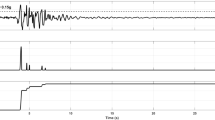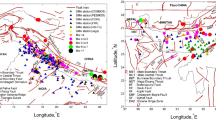Abstract
Earthquake-induced landslides are considered the third-largest contributor of societal damages caused by an earthquake. Newmark sliding displacement method-based regional seismic landslide hazard assessment is widely used by researchers for identifying vulnerable slopes for a future seismic event. For this purpose, several researchers have proposed regression-based Newmark slope displacement prediction equations based on various ground motion intensity measures and critical acceleration as the slope representative parameter. However, the standard deviation values of these models are significantly high. In this present work, first of its kind, new artificial neural network-based data-driven prediction models for Newmark’s sliding displacement are developed. Different combinations of ground motion intensity parameters (PGA, PGV, Ia, and Tm) and the slope’s critical acceleration value are employed to predict slope displacement. A total of nineteen prediction models (five scalars and fourteen vectors) have been developed using a dataset containing 13,707 slope displacement data points. The ‘efficiency’ and ‘sufficiency’ study of present models reveals that these models exhibit better performance than existing prediction models. A comparative study with existing models shows that the present models are consistent in terms of displacement patterns. The application of the developed prediction model is demonstrated by performing seismic landslide hazard assessment for slopes in Shimla City, India.










Similar content being viewed by others
References
Abrahamson NA, Silva WJ, Kamai R (2014) Summary of the ask14 ground motion relation for active crustal regions. Earthq Spectra 30(3):1025–1055
Ahmad I, El Naggar MH, Khan AN (2008) Neural network based attenuation of strong motion peaks in Europe. J Earthq Eng 12(5):663–680
Alavi AH, Gandomi AH (2011) Prediction of principal ground-motion parameters using a hybrid method coupling artificial neural networks and simulated annealing. Comput Struct 89(23–24):2176–2194
Ambraseys N, Menu J (1988) Earthquake-induced ground displacements. Earthq Eng Struct Dyn 16(7):985–1006
Ambraseys N, Srbulov M (1994) Attenuation of earthquake-induced ground displacements. Earthq Eng Struct Dyn 23(5):467–487
Bakhshi H, Bagheri A, Ghodrati Amiri G, Barkhordari MA (2014) Estimation of spectral acceleration based on neural networks. Proc Inst Civ Eng Struct Build 167(8):457–468
Boore DM, Stewart JP, Seyhan E, Atkinson GM (2014) Nga-west2 equations for predicting pga, pgv, and 5% damped psa for shallow crustal earthquakes. Earthq Spectra 30(3):1057–1085
Bray JD, Macedo J, Travasarou T (2018) Simplified procedure for estimating seismic slope displacements for subduction zone earthquakes. J Geotech Geoenviron Eng 144(3):04017124
Bray JD, Travasarou T (2007) Simplified procedure for estimating earthquake-induced deviatoric slope displacements. J Geotech Geoenviron Eng 133(4):381–392
Campbell KW, Bozorgnia Y (2014) Nga-west2 ground motion model for the average horizontal components of pga, pgv, and 5% damped linear acceleration response spectra. Earthq Spectra 30(3):1087–1115
Derras B, Bard PY, Cotton F (2014) Towards fully data driven ground-motion prediction models for Europe. Bull Earthq Eng 12(1):495–516
Derras B, Bard P-Y, Cotton F (2016) Site-condition proxies, ground motion variability, and data-driven gmpes: insights from the nga-west2 and resorce data sets. Earthq Spectra 32(4):2027–2056
Dhanya J, Raghukanth STG (2018) Ground motion prediction model using artificial neural network. Pure Appl Geophys 175(3):1035–1064
Dhanya J, Raghukanth STG (2020) Neural network-based hybrid ground motion prediction equations for western Himalayas and North-Eastern India. Acta Geophys 1–22
Foulser-Piggott R, Stafford PJ (2012) A predictive model for arias intensity at multiple sites and consideration of spatial correlations. Earthq Eng Struct Dyn 41(3):431–451
Hsieh SY, Lee CT (2011) Empirical estimation of the newmark displacement from the arias intensity and critical acceleration. Eng Geol 122(1–2):34–42
Jibson RW (2007) Regression models for estimating coseismic landslide displacement. Eng Geol 91(2–4):209–218
Khosravikia F, Clayton P, Nagy Z (2019) Artificial neural network-based framework for developing ground-motion models for natural and induced earthquakes in Oklahoma, Kansas, and Texas. Seismol Res Lett 90(2A):604–613
Luco N, Cornell CA (2007) Structure-specific scalar intensity measures for near-source and ordinary earthquake ground motions. Earthq Spectra 23(2):357–392
Muthuganeisan P, Raghukanth S (2016) Site-specific probabilistic seismic hazard map of Himachal Pradesh India. Part i. Site-specific ground motion relations. Acta Geophys 64(2):336–361
Muthuganeisan P, Raghukanth S (2016) Site-specific probabilistic seismic hazard map of Himachal Pradesh India. Part ii. Hazard estimation. Acta Geophys 64(4):853–884
Newmark NM (1965) Effects of earthquakes on dams and embankments. Geotechnique 15(2):139–160
Rathje EM, Antonakos G (2011) A unified model for predicting earthquake-induced sliding displacements of rigid and flexible slopes. Eng Geol 122(1–2):51–60
Refice A, Capolongo D (2002) Probabilistic modeling of uncertainties in earthquake-induced landslide hazard assessment. Comput Geosci 28(6):735–749
Rodríguez-Peces M, García-Mayordomo J, Azañón J, Jabaloy A (2014) Gis application for regional assessment of seismically induced slope failures in the sierra Nevada range, South Spain, along the Padul fault. Environ Earth Sci 72(7):2423–2435
Saygili G, Rathje EM (2008) Empirical predictive models for earthquake-induced sliding displacements of slopes. J Geotech Geoenviron Eng 134(6):790–803
Saygili G, Rathje EM (2009) Probabilistically based seismic landslide hazard maps: an application in southern California. Eng Geol 109(3–4):183–194
Travasarou T, Bray JD, Abrahamson NA (2003) Empirical attenuation relationship for arias intensity. Earthq Eng Struct Dyn 32(7):1133–1155
Tsai C-C, Chien Y-C (2016) A general model for predicting the earthquake-induced displacements of shallow and deep slope failures. Eng Geol 206:50–59
Xie Y, Ebad Sichani M, Padgett JE, DesRoches R (2020) The promise of implementing machine learning in earthquake engineering: a state-of-the-art review. Earthq Spectra 36(4):1769–1801
Yegian M, Marciano E, Ghahraman VG (1991) Earthquake-induced permanent deformations: probabilistic approach. J Geotech Eng 117(1):35–50
Author information
Authors and Affiliations
Corresponding author
Ethics declarations
Conflict of interest
The authors declare that they have no conflict of interests or personal relationships that could have appeared to influence the work reported in this paper.
Additional information
Publisher's Note
Springer Nature remains neutral with regard to jurisdictional claims in published maps and institutional affiliations.
Rights and permissions
About this article
Cite this article
Nayek, P.S., Gade, M. Artificial neural network-based fully data-driven models for prediction of newmark sliding displacement of slopes. Neural Comput & Applic 34, 9191–9203 (2022). https://doi.org/10.1007/s00521-022-06945-8
Received:
Accepted:
Published:
Issue Date:
DOI: https://doi.org/10.1007/s00521-022-06945-8




